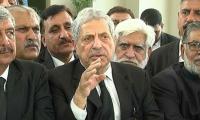ISLAMABAD: The external financing requirement forecast at $35 billion for the current fiscal year seems grossly inflated which, a senior economist viewed, may have been projected by the IMF on the behest of the incumbent government.
“It is higher by at least $10 billion than the actual requirement of the country. It is part of the game plan to demonstrate there is no other option but to seek the IMF loan to avoid default,” said Dr Ashfaque Hassan Khan while talking to The News.
Khan said the current account deficit (CAD) was expanded to $17.4 billion by design for the last fiscal year because the incumbent regime wanted to see it at $19 billion.
Giving insights on how the current account deficit was tweaked to go up, the economist said the petroleum imports surged 103 percent in the last two months as the government had sourced $6.4 billion worth of fuels/oil just in order to build buffer stocks for a period of one month. “All of this is done on purpose to show the current account deficit has worsened,” he added.
Sharing the break-up of higher CAD for the last fiscal year, he said the government had imported $3.5 billion vaccines for Covid-19 pandemic and it was a one-off phenomenon. The government imported additional petroleum products worth $3 billion to reduce the CAD drastically in the current fiscal year, he added. He was of the view that the CAD could be reduced by up to $7 billion for the current fiscal year.
On external loan repayments, he said the government required $12 to $13 billion, so in totality the financing requirements could be curtailed at $20 billion. Khan further said that the loan rollover was being used as a tool to show increased debt servicing requirements.
“If the government has decided to build up its foreign exchange reserves by $5 billion, then they cannot be increased beyond $25 billion for the whole fiscal year.
However, the IMF and Pakistani authorities have assessed that Islamabad requires $34-$35 billion external financing and in addition the country was making efforts to get $4 billion more from friendly countries to stretch its total financing close to $39 billion for the current fiscal year.”
According to renowned economist and former finance minister Dr Hafiz A Pasha, the country’s external debt servicing requirements stand at $22 billion, including rollover of loans from bilateral creditors.
Talking to The News, Pasha said the CAD was estimated at around $10 billion for this fiscal year so the country actually needed a whopping $32 billion worth of external financing.
“The government also needs to jack up the country’s dwindling foreign currency reserves, which currently stood at $8.385 billion (held by the central bank), and were required to be increased to $17 billion.”
Dr Pasha said in total the country would have to arrange external financing worth $40 billion this fiscal year.
As the credit rating agencies had downgraded Pakistan’s ratings, the country would have to pay higher yield on its international bonds, he said, adding that the commercial borrowings would also become expansive. He said another alarming aspect was down-trending exports, which might persist in months ahead.
However, according to him, one redeeming factor could be cooling down world oil prices, which if they remained below $100 per barrel then Pakistan could reap some serious benefits. In the same breath, he warned that the country’s power sector was a cash black hole, causing its financing requirement to balloon to the tune of Rs1,650 billion per annum, which was more than the annual defence budget of the country.
Participants of the Shanghai Cooperation Organisation summit attend an extended-format meeting of heads of SCO member...
Lucky cement factory can be seen in this image. — Lucky Cement website/FileKARACHI: Lucky Cement has announced the...
An image of a woman wearing gold bangles. — AFP/fileKARACHI: Gold prices rose by Rs1,100 per tola on Tuesday in the...
A worker operates a machine preparing fabric at the Kohinoor Textile Mills in Lahore on July 20, 2023. — AFPKARACHI:...
Election officials transport ballot boxes during Japan's upper house election at a counting centre in Tokyo, Japan,...
Labourers load coal onto a supply truck on April 6, 2017.— Reuters/fileLAHORE: Social compliance in Pakistan is...







